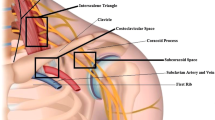Abstract
Purpose
To analyse the significance of risk factors and the possibility of prediction of shoulder dystocia.
Methods
This was a retrospective cohort study. There were 9,767 vaginal deliveries at 37 and more weeks of gestation analysed during 2005–2007. Studied population included 234 deliveries complicated by shoulder dystocia. Shoulder dystocia was defined as a delivery that required additional obstetric manoeuvres to release the shoulders after gentle downward traction has failed. First, a univariate analysis was done to identify the factors that had a significant association with shoulder dystocia. Parity, age, gestation, induction of labour, epidural analgesia, birth weight, duration of second stage of labour and mode of delivery were studied factors. All factors were then combined in a multivariate logistic regression analysis. Adjusted odds ratios (Adj. OR) with 95% confidence intervals (CI) were calculated.
Results
The incidence of shoulder dystocia was 2.4% (234/9,767). Only mode of delivery and birth weight were independent risk factors for shoulder dystocia. Parity, age, gestation, induction of labour, epidural analgesia and duration of second stage of labour were not independent risk factors. Ventouse delivery increases the risk of shoulder dystocia almost 3 times, forceps delivery comparing to the ventouse delivery increases risk almost 3.4 times. Risk of shoulder dystocia is minimal with the birth weight of 3,000 g or less.
Conclusion
It is difficult to foretell the exact birth weight and the mode of delivery, therefore occurrence of shoulder dystocia is highly unpredictable. Regular drills for shoulder dystocia and awareness of increased incidence with instrumental deliveries are important to reduce fetal and maternal morbidity and mortality.
Similar content being viewed by others
References
Resnick R (1980) Management of shoulder dystocia girdle. Clin Obstet Gynecol 23:559–564
Al Hadi M, Geary M, Byrne P, McKennaet P (2001) Shoulder dystocia: risk factors and maternal and perinatal outcome. J Obstet Gynaecol 21:352–354
Gherman RB, Chauhan S, Ouzounian JG, Lerner H, Gonik B, Goodwin TM (2006) Shoulder dystocia: the unpreventable obstetric emergency with empiric management guidelines. Am J Obstet Gynecol 195:657–672
Gherman RB, Ouzounain JG, Goodwin TM (1998) Obstetric maneuvres for shoulder dystocia and associated fetal morbidity. Am J Obstet Gynecol 178:1126–1130
Gherman RB, Goodwin TM, Souter I, Neumann K, Ouzounian JG, Paul RH (1997) The McRobert’s maneuver for the alleviation of shoulder dystocia: how successful is it? Am J Obstet Gynecol 176:656–661
Gherman RB, Ouzounian JG, Miller DA, Kwok L, Goodwin TM (1998) Spontaneous vaginal delivery: a risk factor for Erb’s palsy? Am J Obstet Gynecol 178:423–427
Evans-Jones G, Kay SP, Weindling AM, Cranny G, Ward A, Bradshaw A, Hernon C (2003) Congenital brachial plexus injury:incidence, causes and outcome in the UK and Republic of Ireland. Arch Dis Child Fetal Neonatal Ed 88:185–189
Revicky V, Nirmal D, Mukhopadhyay S, Morris EP, Nieto JJ (2010) Could a mediolateral episiotomy prevent obstetric anal sphincter injury? Eur J Obstet Gynecol Reprod Biol 150:142–146
Bahar AM (1996) Risk factors and fetal outcome in cases of shoulder dystocia compared with normal deliveries of a similar birthweight. Br J Obstet Gynaecol 103:868–872
Mazouni C, Porcu G, Cohen-Solal E, Heckenroth H, Guidicelli B, Bonnier P, Gamerre M (2006) Maternal and anthropomorphic risk factors for shoulder dystocia. Acta Obstet Gynecol Scand 85:567–570
Kolderup LB, Laros RK Jr, Musci TJ (1997) Incidence of persistent birth injury in macrosomic infants: Association with mode of delivery. Am J Obstet Gynecol 177:37–41
Geary M, McParland P, Johnson H, Stronge J (1995) Shoulder dystocia—is it predictable? Eur J Obstet Gynecol Reprod Biol 62:15–18
McFarland MB, Langer O, Piper JM, Berkus MD (1996) Perinatal outcome and the type and number of maneuvers in shoulder dystocia. Int J Gynaecol Obstet 55:219–224
Nesbitt TS, Gilbert WM, Herrchen B (1998) Shoulder dystocia and associated risk factors with macrosomic infants born in California. Am J Obstet Gynecol 179:476–480
Acker DS, Sachs BP, Friedman EA (1985) Risk factors for shoulder dystocia. Obstet Gynecol 66:762–768
Rouse DJ, Owen J (1999) Prophylactic caesarean delivery for fetal macrosomia diagnosed by means of ultrasonography––A Faustian bargain? Am J Obstet Gynecol 181:332–338
Gherman RB (2002) Shoulder dystocia: an evidence-based evaluation of the obstetrical nightmare. Clinical Obstet Gynecol 45:345–362
Athukorala C, Middleton P, Crowther CA (2006) Intrapartum interventions for preventing shoulder dystocia. Cochrane Database Syst Rev 4:CD005543
Maternal and Child Health Research Consortium (1998) confidential enquiries into stillbirths and deaths in infancy. Fifth annual report. Focus Group Shoulder Dystocia, London
Mikolajczyk RT, DiSilvestro A, Zhang J (2008) Evaluation of logistic regression reporting in current obstetrics and gynecology literature. Obstet Gynecol 111:413–419
Dyachenko A, Ciampi A, Fahey J, Mighty H, Oppenheimer L, Hamilton EF (2006) Prediction of risk for shoulder dystocia with neonatal injury. Am J Obstet Gynecol 195:1544–1549
Jazayeri A, Heffron JA, Phillips R, Spellacy WN (1999) Macrosomia prediction using ultrasound fetal abdominal circumference of 35 centimeters or more. Obstet Gynecol 93:523–526
Hernandez C, Wendel GD (1990) Shoulder dystocia. Clinical Obstet and Gynecol 33:526–534
Kjos SL, Henry OA, Montoro M, Buchanan TA, Mestman JH (1993) Insulin-requiring diabetes in pregnancy: a randomized trial of active induction of labor and expectant management. Am J Obstet Gynecol 169:611–615
Royal College of Obstetricians and Gynaecologists (RCOG) (2005) Shoulder dystocia (Green-top guideline; no. 42). Royal College of Obstetricians and Gynaecologists, London. http://www.rcog.org.uk/womens-health/clinical-guidance/shoulder-dystocia-green-top-42. accessed 16 May 2010
Gonen O, Rosen DJ, Dolfin Z, Tepper R, Markov S, Fejgin MD (1997) Induction of labor versus expectant management in macrosomia: a randomized study. Obstet Gynecol 89:913–917
Conflict of interest
None.
Author information
Authors and Affiliations
Corresponding author
Rights and permissions
About this article
Cite this article
Revicky, V., Mukhopadhyay, S., Morris, E.P. et al. Can we predict shoulder dystocia?. Arch Gynecol Obstet 285, 291–295 (2012). https://doi.org/10.1007/s00404-011-1953-3
Received:
Accepted:
Published:
Issue Date:
DOI: https://doi.org/10.1007/s00404-011-1953-3




